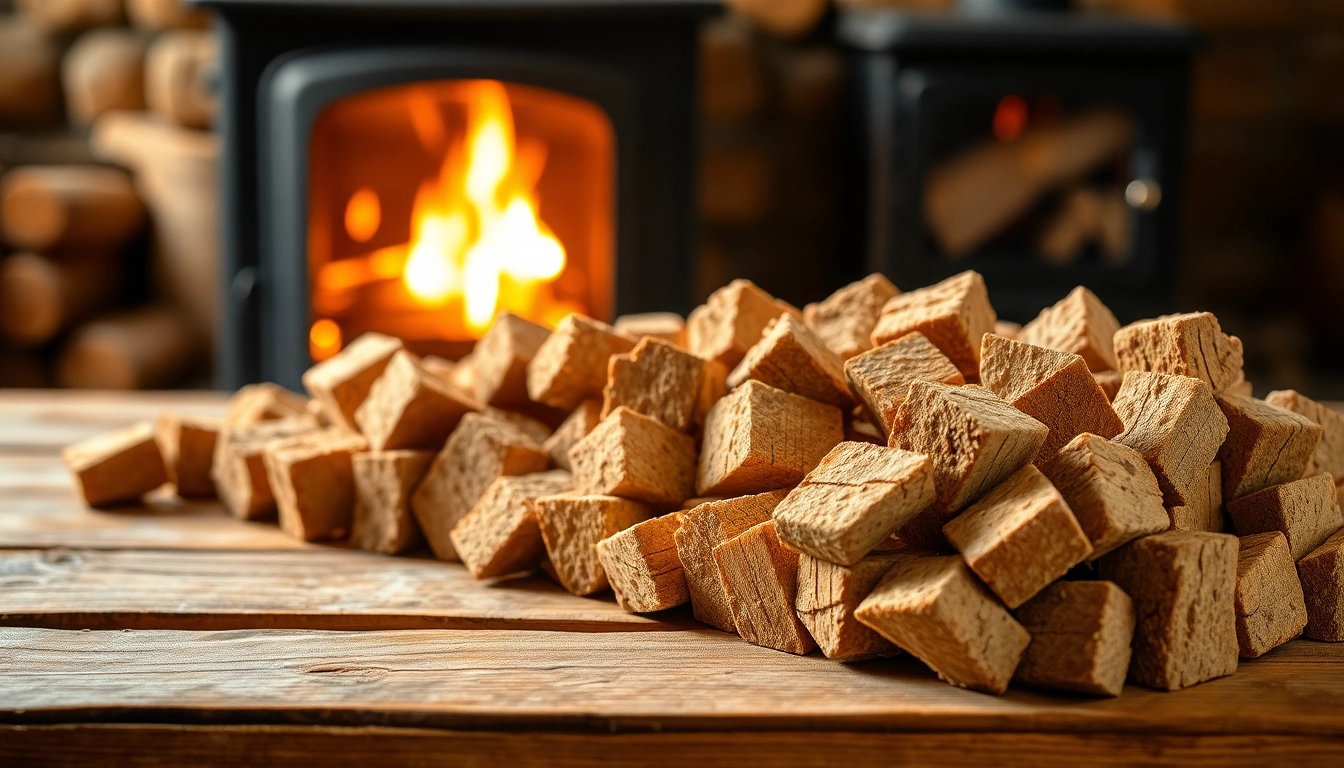Understanding Wood Briquettes: An Overview
What Are Wood Briquettes?
Wood briquettes are an alternative solid fuel derived from compressed sawdust or wood waste. Unlike traditional firewood, briquettes offer more consistent burning characteristics and higher energy density, making them a favored choice for both heating and cooking applications. These cylindrical blocks are typically made from a range of different types of wood, including hardwoods and softwoods, and they are produced by compressing the raw material under high pressure. The absence of added chemicals and binders makes them an environmentally friendly option for sustainable living and energy consumption.
Benefits of Using Wood Briquettes
The advantages of utilizing wood briquettes as a fuel source are numerous:
- High Heat Output: Briquettes typically offer greater heat output when compared to traditional logs, allowing for efficient heating of homes or cooking.
- Lower Moisture Content: With a moisture content between 7-10%, briquettes burn more effectively and produce less smoke and creosote, which can build up in chimneys.
- Eco-friendly: Made from recycled wood fibers, they are a sustainable choice for heating needs, contributing to forest preservation.
- Convenience: They are easier to store and handle than firewood, taking up less space and reducing preparation time before burning.
Types of Wood Briquettes Available
When exploring options for wood briquettes, consumers will encounter a variety of types:
- Hardwood Briquettes: These are made from hardwood species like oak and beech, offering a longer burn time and higher heat output.
- Softwood Briquettes: Typically used for quick cooking and shorter burn times, softwood briquettes burn faster and ignite easier.
- Blended Briquettes: These may contain a mix of hardwood and softwood for a balanced performance suitable for various heating needs.
- Compressed Pellets: While technically distinct, pellets share many properties with briquettes and are often used in high-efficiency stoves.
Criteria for Evaluating the Best Wood Briquettes Europe
Burn Efficiency and Heat Output
Burn efficiency is a critical factor when selecting wood briquettes. Efficient briquettes produce more heat with less fuel consumed. Look for briquettes that can sustain a steady burn for an extended period. The calorific value (measured in kWh/kg) is a valuable metric to assess. A higher calorific value indicates that the briquettes will offer more energy per unit, making them more cost-effective and environmentally friendly. When comparing various brands, consider conducting burn tests to verify real-world performance versus claims.
Environmental Impact and Sustainability
As sustainability continues to be a crucial consideration, evaluating the environmental impact of wood briquettes becomes essential. Look for products made from Best wood briquettes Europe that adhere to eco-friendly manufacturing processes. Certifications such as FSC (Forest Stewardship Council) or PEFC (Programme for the Endorsement of Forest Certification) confirm that the raw materials are sourced responsibly. Additionally, consider the overall carbon footprint of the production process, packaging, and transportation of the briquettes.
Cost and Value Assessment
Cost is often a significant factor when purchasing wood briquettes. Balance the initial purchase price with long-term value. While cheaper briquettes may seem appealing, they might not offer the heat output or burn time needed, leading to higher overall costs. Assess the cost per kWh burned to understand the value. Quality briquettes, while more expensive upfront, can deliver superior performance and longevity, ultimately resulting in savings in heating costs over time.
Top Recommendations for Best Wood Briquettes Europe
Comparative Analysis of Popular Brands
When choosing the best wood briquettes in Europe, several brands have consistently received positive reviews for their quality and performance:
- Hardwood Briquettes: Known for their high density and calorific value, hardwood briquettes are often favored for heating applications. They provide a long-lasting burn with excellent heat output.
- Softwood Briquettes: Great for quick ignition and high-temperature cooking, these briquettes are ideal for outdoor barbecue setups or indoor hearths requiring quick heat.
- Eco-Friendly Briquettes: Brands focusing on sustainable sourcing also produce briquettes that create less ash and emissions, ensuring a cleaner burn with minimal environmental impact.
User Reviews and Feedback
User feedback is a vital resource for determining the best wood briquettes. It’s beneficial to explore online forums, review sites, and community discussions to gain insight into experiences with different products. Users often mention specific attributes such as ease of use, burn time, and efficiency. Additionally, consider looking for reviews that compare performance in different applications, such as residential heating versus barbecue grilling.
Where to Purchase Quality Wood Briquettes
Finding a reliable supplier for wood briquettes can significantly affect quality assurance. Local hardware stores, garden centers, and online marketplaces often stock really good options. When purchasing online, ensure that the site has a good return policy and read customer reviews to gauge credibility. Acquiring samples or small quantities for trial before purchasing in bulk can also help ensure satisfaction with the product.
Usage Tips for Optimal Performance
Storing Wood Briquettes Properly
Storing wood briquettes correctly is essential to maintain their quality and efficiency. They should be kept in a dry environment, as moisture can significantly reduce their burning efficiency. Store briquettes off the ground, possibly on wooden pallets, and in a sheltered position to protect them from rain and humidity. A dedicated wood shed can also work well if it is well-ventilated to prevent moisture buildup.
Best Practices for Burning Wood Briquettes
For optimal performance, follow these burning tips:
- Ignition: Use kindling or paper to start the fire, ensuring good airflow to prevent smoke build-up.
- Load Carefully: Avoid overloading the stove; maintain enough space for air circulation to enhance the combustion process.
- Monitor Temperature: Use a thermometer to keep track of the stove temperature; this will help prevent the briquettes from burning too quickly.
Combining Briquettes with Other Fuels
For enhanced performance, consider combining wood briquettes with other fuel sources. Mixing briquettes with smaller logs can create a more dynamic burn, enhancing heat efficiency and prolonging burn time. Additionally, certain types of charcoal can be added for increased heat output, particularly in outdoor cooking settings. Experimentation with different combinations can lead to optimal results for specific heating or cooking needs.
Future Trends in Wood Briquette Production
Innovations in Manufacturing Techniques
The production of wood briquettes is evolving, with innovations aimed at increasing efficiency. Advanced compression technology has allowed for denser briquettes with improved calorific values. Moreover, integrating waste materials from various industries as feedstock for briquette production can enhance resource circularity and reduce environmental impact.
Health and Safety Standards
As the market for wood briquettes grows, adherence to health and safety standards becomes paramount. Regulatory bodies are increasingly focusing on emissions during combustion and the safety of materials used. Standards ensure that consumers are getting quality products that minimize harmful pollutants released during burning.
The Shift Towards Sustainable Wood Sources
There’s a growing emphasis on sustainability in the production of wood briquettes. Future trends likely include sourcing wood from sustainably managed forests, utilizing agricultural residues, and exploring alternative vegan-friendly fuel materials such as compressed agricultural waste. This commitment to sustainability will enhance the commercial viability of wood briquettes while supporting the global movement towards renewable energy sources.


